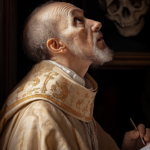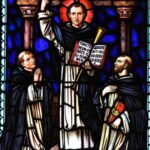St. Francis Borgia
St. Francis Borgia
St. Francis Borgia: A Remarkable Journey through History
When they lived: St. Francis Borgia, also known as Francisco de Borja, lived during the Renaissance period. He was born on October 28, 1510, and passed away on September 30, 1572.
Where they lived: St. Francis Borgia hailed from the illustrious Borgia family in Gandia, a picturesque town located in the province of Valencia, Spain.
Notable world events during the time of their life:
- 1517 – Martin Luther’s Ninety-Five Theses: In the year 1517, the world witnessed a turning point in religious history when Martin Luther, a German monk, publicly criticized the practices of the Catholic Church through his famous Ninety-Five Theses. This event sparked the Protestant Reformation, leading to significant religious and political upheavals across Europe.
- 1543 – Copernicus’ On the Revolutions of the Heavenly Spheres: In 1543, Nicolaus Copernicus, a Renaissance mathematician and astronomer, published his groundbreaking work “On the Revolutions of the Heavenly Spheres.” This book presented a heliocentric model of the solar system, challenging the geocentric beliefs that had dominated for centuries and paving the way for modern astronomy.
- 1565 – The Great Siege of Malta: The Mediterranean witnessed a dramatic event in 1565 when the Ottoman Empire launched a massive invasion of the island of Malta, defended by the Knights Hospitaller. The siege lasted four months and became a legendary tale of bravery and resilience.
- 1572 – The St. Bartholomew’s Day Massacre: In this fateful year, France was plagued by religious tensions between Catholics and Protestants. The St. Bartholomew’s Day Massacre was a gruesome episode where thousands of Huguenots (French Protestants) were brutally killed, sending shockwaves across Europe.
Their Patronage: St. Francis Borgia is known as the patron saint of several diverse causes. He is the patron saint of those suffering from earthquakes, as he demonstrated unwavering compassion and aid during a severe earthquake in Messina, Sicily, in 1542. Furthermore, he is also recognized as the patron saint of those facing a difficult death, drawing from his experiences as he attended to the dying with immense care and spiritual guidance.
Early Life
He was born in the Duchy of Gandia, Valencia, on October 28, 1510. From childhood, he was spiritual and desired to become a monk.
He was a kinsman at the court of Charles V, Holy Roman Emperor, and also accompanied the emperor on several campaigns. He completed his education in Saragossa, Spain.
Adult Life
In September 1529, in Madrid, he married a Portuguese noblewoman, Eleanorde Castro, and they had eight children.
In 1539 (at age 29), he became Viceroy of the Spanish region of Catalonia, where he carried out community and economic reforms.
He composed different musical ecclesiastical pieces and exposed a contrapuntal style, and in the sixteenth century, he was the chief restorer of sacred music.
In 1543, his father (3rd Duke of Gandia) died, and Borgia resigned himself as a duke and gave his title to his son, Carlos.
At the age of 33, after his wife’s death, Eleanor, in 1546, he devoted himself to religious practice, entered the Society of Jesus, and became a Jesuit priest.
Lifetime Accomplishments
He established the Jesuit College in Gandia; in 1547, it changed its name to the University; he also helped in the establishment of the Gregorian University in Rome.
He established new provinces (Peru and New Spain) and colleges in Europe. He also founded the Collegium Romanum in Rome.
For foreign missions, he asked St. Pius to adopt two major policies: first, to compact their government; second, to treat the local people group compassionately to win their confidence.
Life at a Monastery
In Spain, 1551, he was ordained a clergyman, and being sick and poor for his last years, he left the governance and started ventures for the society with full passion and devotion.
He was a man of his thoughts and drew much strength from the silence of his prayer. After a year, he left for Spain and started preaching there. Many worshippers from far and wide heard him preach.
On July 2, 1565, he was elected as the third “Father General”, and closely administered all the undertakings of the rapidly extending order.
Death, Canonization, and Patronage
- His triumphs during the period 1565–1572 have caused students of
history to portray Francis as one of the most prominent saints.
5 Interesting Facts About St. Francis Borgia
- After his death, there appeared, in the constellation known as
Cassiopeia’s Chair.
3. He had been one of the most noticeable examples of the conversion of
souls in the Catholic Church after the Renaissance.
4. He was a supernatural occurrence; her mother, the duchess, made a vow,
If she delivers a living son, she will give him the name Seraphic.
Saint, Hours afterward, his birth was a wonder; the infant was lively.
and a boy. - In 1566, Francis Borgia confined the task of safeguarding the city to
As pope, he organized methods of calmness according to his religious abilities and
broken out the pestilential fever.
Prayer to St. Francis Borgia
O Lord Jesus Christ,Who art both the example and the reward of true humility, we beseech Thee that even as Thoudidst make blessed Francis glorious by following Thee in despising earthly honors, so Thou wouldst suffer us also to become his companions alike in following Thee and in his glory. Who liveth and reigneth with God the Father in the unity of the Holy Ghost, one God, world without end. Amen.



